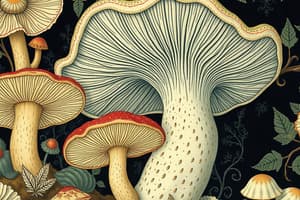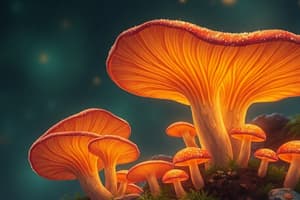Podcast
Questions and Answers
What organism group do fungi belong to, based on their nutrient requirements?
What organism group do fungi belong to, based on their nutrient requirements?
Fungi are heterotrophs, requiring organic carbon for nutrition.
Describe the difference between saprotrophs and symbiotic fungi.
Describe the difference between saprotrophs and symbiotic fungi.
Saprotrophs decompose dead organic matter, while symbiotic fungi interact with other species, often benefiting both organisms.
What is the primary component of the cell wall in fungi?
What is the primary component of the cell wall in fungi?
The cell wall of fungi is made up of chitin.
What is the term for the long branching structures found in molds?
What is the term for the long branching structures found in molds?
How do zygomycetes differ from ascomycetes in their reproductive structures?
How do zygomycetes differ from ascomycetes in their reproductive structures?
In throat cultures, what does the presence of clear zones on a blood agar plate signify?
In throat cultures, what does the presence of clear zones on a blood agar plate signify?
What type of culture medium is typically used to diagnose urinary tract infections?
What type of culture medium is typically used to diagnose urinary tract infections?
Why is a 'clean catch' method important when collecting urine samples?
Why is a 'clean catch' method important when collecting urine samples?
What is the gas environment required for the growth of obligate anaerobes?
What is the gas environment required for the growth of obligate anaerobes?
What is significant bacteriuria in terms of UTI diagnosis?
What is significant bacteriuria in terms of UTI diagnosis?
What is the purpose of the GasPak system in culturing facultative pathogens?
What is the purpose of the GasPak system in culturing facultative pathogens?
Identify two types of vectors that transmit disease-causing organisms.
Identify two types of vectors that transmit disease-causing organisms.
What role do antibodies play in the immune response?
What role do antibodies play in the immune response?
Explain the importance of washing steps in the ELISA test.
Explain the importance of washing steps in the ELISA test.
What results indicate a positive reaction in an ELISA test?
What results indicate a positive reaction in an ELISA test?
Why is a negative control group necessary in ELISA testing?
Why is a negative control group necessary in ELISA testing?
Describe how the Biolog system identifies bacteria.
Describe how the Biolog system identifies bacteria.
What does a purple color indicate in a Biolog system test?
What does a purple color indicate in a Biolog system test?
How is turbidity measured to estimate the concentration of bacteria in suspension?
How is turbidity measured to estimate the concentration of bacteria in suspension?
What issues can arise from inoculating too much bacteria in a Biolog system test?
What issues can arise from inoculating too much bacteria in a Biolog system test?
Flashcards
Facultative Pathogens
Facultative Pathogens
Microorganisms that can survive and grow with or without oxygen.
Vector
Vector
Organism that transmits a disease-causing microbe.
Mechanical Vector
Mechanical Vector
Carries a pathogen on its body, not inside.
Biological Vector
Biological Vector
Signup and view all the flashcards
Antigen
Antigen
Signup and view all the flashcards
Antibody
Antibody
Signup and view all the flashcards
Fungi heterotrophs
Fungi heterotrophs
Signup and view all the flashcards
ELISA Test
ELISA Test
Signup and view all the flashcards
Biolog System
Biolog System
Signup and view all the flashcards
Saprotrophs
Saprotrophs
Signup and view all the flashcards
Turbidimeter
Turbidimeter
Signup and view all the flashcards
Hyphae
Hyphae
Signup and view all the flashcards
Transmittance
Transmittance
Signup and view all the flashcards
Mycelium
Mycelium
Signup and view all the flashcards
A-hemolytic
A-hemolytic
Signup and view all the flashcards
B-hemolytic
B-hemolytic
Signup and view all the flashcards
Throat culture
Throat culture
Signup and view all the flashcards
Urine Culture
Urine Culture
Signup and view all the flashcards
Anaerobic pathogens
Anaerobic pathogens
Signup and view all the flashcards
Obligate anaerobes
Obligate anaerobes
Signup and view all the flashcards
Study Notes
Fungi
- Fungi are heterotrophs, meaning they require organic carbon for survival.
- They are often saprotrophs, decomposing dead organic matter.
- They can form symbiotic relationships with other species like algae or bacteria.
- Fungi serve as a food source and are involved in food production for humans and other organisms.
- Fungi have cell walls composed of chitin.
- They can be multicellular (molds) or unicellular (yeasts).
- Fungi have hyphae, long branching cellular structures forming mycelium (an invisible mat).
- Vegetative hyphae grow along the substrate.
- Reproductive hyphae extend upwards to produce spores.
- Fungi exhibit thermal dimorphism, growing as molds at room temperature and as yeast at 37°C.
- Some fungi are opportunistic pathogens, infecting weak or immunocompromised individuals.
- Zygomycetes: Form zygospores during sexual reproduction and sporangiospores during asexual reproduction (e.g., Rhizopus stolonifer).
- Ascomycetes: Form ascospores during sexual reproduction and conidiospores during asexual reproduction (e.g., Penicillium notatum, Aspergillus niger).
- Basidiomycetes: Form basidiospores during sexual reproduction (e.g., mushrooms).
Infectious Disease
-
Throat Cultures: Blood agar plates (containing 5% sheep's blood) are used to determine hemolysis:
- Alpha-hemolysis: Partial breakdown of red blood cells (RBCs), green coloration.
- Beta-hemolysis: Complete breakdown of RBCs, clear zones.
- Gamma-hemolysis: No breakdown of RBCs. (Streptococcus pneumoniae, Streptoccocus pyogenes examples)
-
Urine Cultures: Diagnose urinary tract infections (UTIs), most commonly caused by E. coli.
- Use Eosin Methylene Blue (EMB) and Blood Agar (BA) plates.
- Sterile sample collection crucial.
- “Clean catch” method for urine collection.
- Significant bacteriuria is defined as ≥100,000 organisms/mL of one type.
-
Anaerobic Pathogens: Require GasPak system (removal of free oxygen using a special jar with sachets/chemicals) for growth on TSA plates. (Obligate anaerobes)
-
Facultative Pathogens: Can grow with or without oxygen.
-
Vectors: Transmit diseases through various means:
- Food/water
- Respiratory droplets
- Sexual contact
- Insect vectors (mechanical/biological)
Immunology
- Antigens trigger an immune response; Antibodies are produced to fight them.
- ELISA Test: Used to detect antigens, antibodies (HIV, EBV, pregnancy tests, etc.).
- Colorimetric detection (color change).
- Key steps: Label wells, add viral antigen, wash, add test reagent, add secondary antibody, add substrate.
- Infectious Mononucleosis (Kissing Disease): Transmitted through saliva.
- EBV: Associated with chronic fatigue syndrome.
- Biolog System: Identifies bacteria based on metabolic properties (using 96-well plates, carbon sources, sensitivity tests).
- Purple color indicates positive reaction (bacteria growth)
- Steps include well preparation, sample inoculation, incubation, and analyzing results using light/dye methods
Studying That Suits You
Use AI to generate personalized quizzes and flashcards to suit your learning preferences.
Description
This quiz explores the diverse characteristics and classifications of fungi, including their heterotrophic nature, structural features, and reproductive methods. Learn about the different types of fungi, such as Zygomycetes and Ascomycetes, and their roles in ecosystems and human life.



